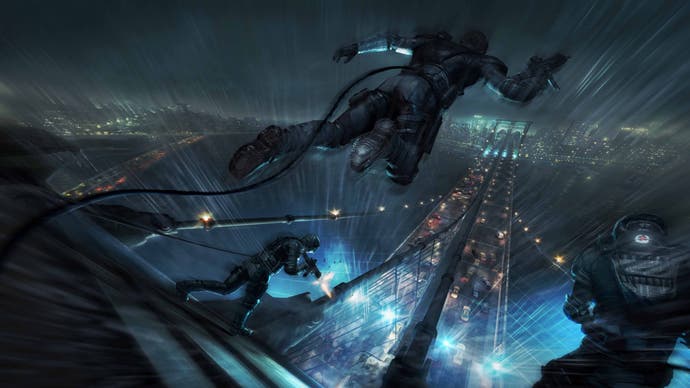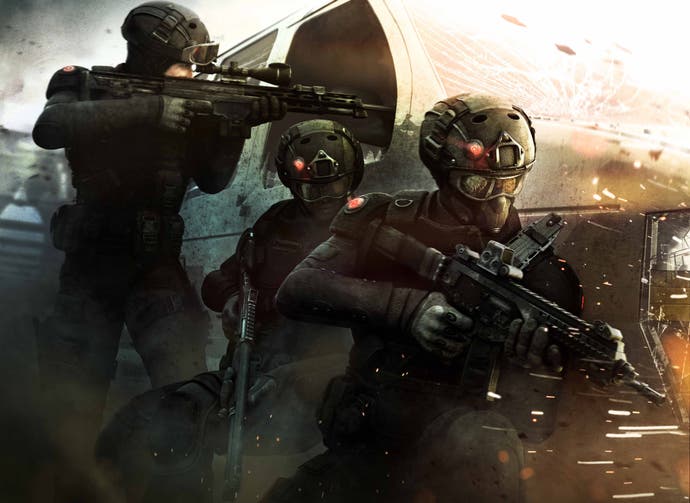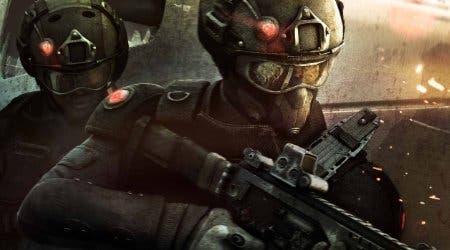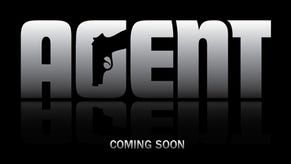Rainbow 6 Patriots Preview
Can shock factor put Ubi's tactical shooter back on top in 2013?
By now, you may well have seen the target footage of Rainbow 6 Patriots that Ubisoft released earlier this month, hot on the heels of a hurried announcement. Not much more than a week previously, I'd been sitting in Ubisoft's Montreal game factory watching the very same sequence played live on a PS3 - albeit still presented as a "target" rather than a piece of the finished game. It differed in minor details, but it matched the target video beat for beat.
You find yourself in a beautiful house, with a beautiful wife. (Although David Byrne didn't mention the iPad or the option to PRESS X TO KISS WIFE, you way well ask yourself: how did I get here?) You're a successful banker. A group of men break in and capture you both; you wake up with a bomb strapped to your chest, tasked with taking it to Times Square in New York and committing an atrocity to save the lives of your wife and baby. Ending up stuck in traffic chaos on a rain-lashed Brooklyn Bridge, you're cowering under cover from police fire and following one of the terrorists forward, car by car.

The action then switches to the Rainbow counter-terrorist team, high in the bridge's superstructure. You snipe, taking out an interfering NYPD officer with a shot to the leg. You rappel dramatically, running vertically down the brickwork, firing as you go. You make your way forward through panicked civilians, using a stark virtual-reality tactical overlay (not unlike Batman: Arkham's detective mode) to pick out and close in on the enemy.
Eventually you isolate the banker you were playing as, and identifying with, just minutes ago. Your crosshair settles on his terrified face; he's clearly a hostage. There's no time to defuse the bomb, but hurl him into the water before it blows and you might save yourselves and the bridge. You have to decide fast what to do. PRESS X TO ELIMINATE THREAT. Fade to black.
Target or not, this is broadly what to expect from your next Rainbow 6 when it releases in 2013 on PC, PS3 and Xbox 360. Different, isn't it?
The Enemy Within
Rainbow 6 Patriots is a game that really wants your attention. It's been three years since the last entry in the series, Vegas 2, and it will be five by the time Patriots sees the inside of your disc tray. Once the dominant online shooter, Rainbow 6 has been left behind by noisier rivals that have whisked the modern military agenda away from tactical counter-terrorism and plunged it into chaotic war zones and bombastic stunts.
So Ubisoft Montreal is making a lunge for the spotlight with Patriots' story - and how it's told. Your special forces team once again spends most of its time on US soil, but fighting domestic terrorists who don't look or sound different from the man in the street, and whose agenda (still blurry at this stage) seems to be rage at the financial mismanagement of governments and markets. They're led by an internet-age martyr called Jonah Treadway and their unconventional methods will have the Rainbow team constantly reconsidering their own approach and needing to think the unthinkable, such as allowing civilians to die - or even killing them - as they chase Treadway across America.
"There's a tremendous amount of political energy that lacks an avenue for expression," says creative director David Sears, flicking through slides of Tea Party demonstrations, survivalist loons and protesters marching against the global banking collapse. "Americans are very distressed; domestic terrorism is the greatest threat we face." More slides of defiant, masked warriors in camo casual. "Terrorism... is about sending a message: we don't like you." Smiling men in the street. "No-one is safe. Anyone you know could be a terrorist." Stars and stripes. "For us, patriotism equals religion."
If this were propaganda rather than a 'vision presentation' for a video game, it would probably be seen as paranoid scaremongering. But Sears isn't a demagogue, he's a Mississippi-born designer (ex-Zipper Interactive and SOCOM) who's been tasked with coming up with a setting for a counter-terrorism game that still needs to feel relevant and contemporary in two years' time, and that needs to fit the Tom Clancy brief of plausible real-world scenarios. He'd deny it, but you suspect he's been also been asked to come up with something spicy enough to get Rainbow 6 noticed in a world where the competition isn't afraid to deploy a playable airport massacre or the death of a child.
Fortunately for his paymasters, Sears seems to have an aptitude for pushing hot buttons. But he points out that Patriots' scenario is based on the rising numbers of paramilitary and survivalist organisations in the US, and the Depratment of Homeland Security's on-record concern about domestic terrorism. "Terrrorism, to an informed citizen of the world, is an ongoing concern. The more you know about it, the scarier it is, so I think that's what the game does really well. We've researched what terrorists are thinking and how they plan and act."
"The key is respect," says Philippe Therien, the lead designer on Patriots' campaign. "If you respect the subject matter, if it's done in a way that's informative and thought-provoking, it's OK. If it was gratuitous, if it was vulgar, if it was blatantly ripping off horrible moments that happened in American history, it would be bad. But that's not what we're doing."

"We're certainly not trying to make political statements, that's not our job or our mandate," adds Sears. "I don't really see this as any different from a Tom Clancy novel."
In theory, sure. But in practice, Rainbow 6 Patriots is a first-person shooter, a rather different beast to a novel. Where things get interesting is in the Ubisoft team's efforts to bridge this gap and get you to see multiple perspectives on the conflict (and not just those of different branches of the military). Hence the sequence where you're a banker in a bomb vest. Members of Treadway's organisation will also be playable in similar sequences, in an attempt to portray Rainbow's antagonists as more than mere villains. It's hardly the clinical Clancy game we're used to.
If you're alarmed that this represents a shift towards 'Heavy Rainbow 6' (as a friend quipped to me), Sears stresses that such scenes will be in the minority. But, he says, "it's really important that you understand the character that you're about to play.... what motivates them, what their personal attachments are. Because we want to flip that at the earliest opportunity." Therien agrees. "That perspective that you have from playing the bomber, that's important to us. We want to have respect for a life that's about to be lost."
Respect and balance may well be the primary motivations behind this storytelling device, but as Modern Warfare 2's infamous No Russian scene proved, first-person gaming can be a rather blunt narrative tool. The Patriots target demo makes its point powerfully, but it doesn't do it subtly. However, there's no doubting the team's ambition and bravery, or Ubisoft's admirable risk-taking. "It's time-consuming, it requires a lot of overhead, it's expensive... What's surprising to me is that I was allowed to do it," Sears confesses.
Gym'll Fix It
There's another game here, though, the one existing Rainbow 6 fans want to see, and it's demonstrated to us not in a fully-built level but in a development tool. The Gym is a sandbox where the designers can quickly knock up tactical scenarios to test the core of the Rainbow 6 experience, so different from its competitors: using surveillance equipment and squad orders to approach tactical challenges.
"We're all about securing a space, usually an urban space," Sears explains. "Standard operating procedure requires you to move cautiously through these spaces and secure one area after another." So it always was in Rainbow 6, and despite the narrative-led drama of the target demo, so it will continue to be.
In fact, while he wants to make tactical play more accessible, Sears is also keen to make it more realistic and more of a present concern for players, noting that in previous games, it was easy to send your team in to soak up enemy bullets without worrying about casualties before going in to mop up. "You have to use your team constantly," he says of Patriots. "One man goes down, that's a third of your fire-power. I wanted to spend a lot of time on developing AI that behaved intelligently and required you to act as a leader. It was often too easy before. This time we wanted to make it more of a requirement that you be an active leader rather than a passive leader."
The Gym set-up is simple: a single room in a bland brick building, with a corridor leading to it: one door into the corridor, one into the room. Terrorists inside, some on guard, some moving around, some minding hostages. The player, commanding two AI team-mates.

From these basic parameters, Therien proceeds to show us a dizzying number of successful and unsuccessful outcomes based on simple tactical decisions, explaining that in Patriots, positioning and suppressing fire are more important than shooting as many people as quickly as possible. The sheer flexibility of the game systems and AI is very impressive. "It's all made to react to your choices, it's all systemic AI. As much as we're trying to show people what the best thing to do is, and what the options are, it still reacts a lot," says Therien, agreeing that the hard part is exposing this complexity and choice to players without overwhelming them.
The answer to that is the contextual one-button tactical command system. Simply point and press, and your team-mates will understand what you want them to do. (More specific commands will be available to players with more interest in tactical depth and perfect results.) Initially overpowered, the designers have dialled this feature back to the point where they feel it works intuitively.
Explaining the system, Therien argues the most important component of good tactics is timing, and that's something most players will understand. "Just understanding the timing of a situation, when is the right time to act, that's something a lot of other games do. It can be as simple as, when do you leave cover, when do you open the door, when do you cross the street. That goes back to Frogger, we're not reinventing the wheel here."
Visibility and forward planning are part of it, too, and in Patriots these are assisted by the tacitcal overlay that allows you to see through walls with X-ray vision; certainly more powerful than Vegas' fish-eyed snake cam peering under doors. There'll be a limit on its use, so players can't have it permanently engaged. It seems far-fetched, but Therien points out that they've only miniaturised existing technology: "It's completely plausible. It's shocking... the FBI can look through containers, look through the walls of your house."

If the target demo doesn't feel like the Rainbow 6 we know, the Gym demo feels like a better version of the one we do - one that's both easier to use and more powerful, flexible and compelling. The missing component is multiplayer, which we're not shown in much detail, but which seems equally ambitious.
The team lobby is an 'HQ', an actual game space where players can meet, view a model of the map, and even enter a virtual version of it where they can lay down markers and save a custom game plan. In-game, there's a vault move to improve navigation, you can tag enemies to make them visible through walls to your team-mates, and new weapons and abilities are unlocked on the team level rather than for individual players. It's a world away from Call of Duty's twitch deathmatches.
That's the paradox of Patriots: get down to the nitty-gritty, and it seems like a smart series update that understands the strengths of Rainbow 6's gameplay, knows that they set it apart from the competition, and is finding ways to open them up to more players. On the surface, though, and in that controversial target demo, it feels like an attention-seeker trying anything to be heard above the din - and running the risk of tripping over its own ambition as it does so.
Either way, though, it's going to be a hard game to ignore.





